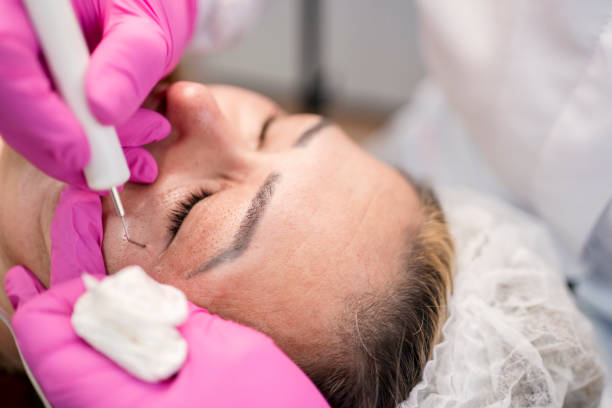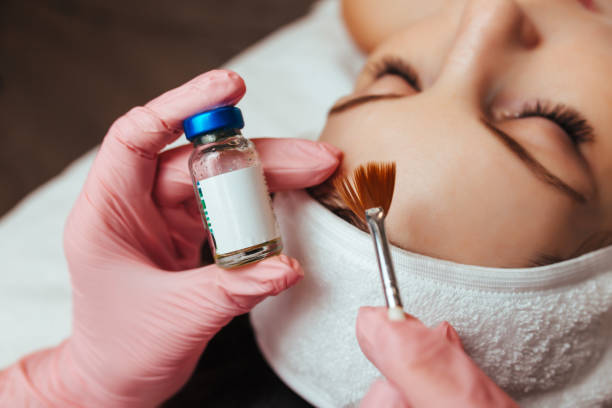

Chemical peels are a popular treatment for improving skin tone and reducing dark spots caused by hyperpigmentation. These peels work by removing the outer layers of the skin, which contain dead cells and pigmentation issues.
When a chemical peel is applied to the skin, it creates controlled damage that stimulates the body's natural healing process. This leads to increased cell turnover, collagen production, and improved skin texture. The chemicals in the peel also help to break down melanin deposits that cause dark spots and uneven pigmentation.
Over time, as the old damaged skin is shed and new, healthier skin regenerates, the complexion becomes more even-toned and radiant. Chemical peels can be customized based on the individual's specific concerns and skin type, making them an effective option for treating hyperpigmentation.
In addition to improving skin tone and reducing dark spots, chemical peels can also address other common skincare issues such as acne scars, fine lines, and sun damage. With regular treatments and proper skincare maintenance, chemical peels can help achieve smoother, brighter, and more youthful-looking skin.
It is important to consult with a qualified skincare professional before undergoing a chemical peel treatment to determine the best approach for your specific needs. By understanding how chemical peels work and their benefits for hyperpigmentation, you can make informed decisions about improving your skin health and appearance.
Hyperpigmentation is a common skin condition that causes dark patches or spots to form on the skin, often as a result of sun exposure, hormonal changes, or inflammation. While there are many treatment options available for hyperpigmentation, chemical peels have become increasingly popular due to their effectiveness in improving skin tone and reducing pigmentation.
Chemical peels work by applying a solution to the skin that exfoliates the top layer of dead skin cells, revealing fresh new skin underneath. This process can help to lighten dark spots and even out skin tone over time. There are several different types of chemical peels available for hyperpigmentation treatment, each with its own benefits and considerations.
Glycolic acid peels are one of the most common types of chemical peels used for hyperpigmentation. They are mild enough for most skin types and can help to improve overall skin texture and tone. Salicylic acid peels are another popular option, particularly for those with acne-prone skin, as they can help to unclog pores and reduce inflammation that may contribute to pigmentation issues.
For more severe cases of hyperpigmentation, stronger chemical peels such as trichloroacetic acid (TCA) peels may be recommended. These peels penetrate deeper into the skin and can provide more dramatic results in terms of lightening dark spots and evening out skin tone. However, they also come with a higher risk of side effects such as redness, swelling, and irritation.
Before undergoing any type of chemical peel treatment for hyperpigmentation, it is important to consult with a skincare professional who can assess your individual needs and recommend the best course of action. It is also crucial to follow post-care instructions carefully in order to maximize results and minimize potential side effects.
In conclusion, chemical peels can be an effective treatment option for hyperpigmentation when performed by a trained professional. By understanding the different types of chemical peels available and their respective benefits, you can make an informed decision about which treatment option is right for you. With proper care and maintenance, you can achieve smoother, more even-toned skin that leaves you feeling confident and radiant.
Chemical peels are a popular cosmetic procedure that can help improve the appearance of your skin by removing dead skin cells and stimulating new cell growth.. Whether you are considering getting a chemical peel or have already had one, it is important to properly prepare for the procedure and take care of your skin during the recovery process.
Before undergoing a chemical peel, it is essential to consult with a qualified dermatologist or skincare professional to determine which type of peel is right for you.

Posted by on 2024-05-22
Dark spots, also known as hyperpigmentation, can be a frustrating skin concern for many people.. Whether they are caused by sun damage, acne scars, or hormonal changes, these dark patches can make us feel self-conscious and less confident in our own skin.
But fear not!

Posted by on 2024-05-22
If you are considering a chemical peel treatment for hyperpigmentation in Frisco, you may be wondering what to expect during and after the procedure.. A chemical peel is a cosmetic treatment that uses a solution to exfoliate the top layers of skin, revealing smoother and more even-toned skin underneath.
During the treatment, your skincare specialist will cleanse your skin and apply the chemical peel solution to the targeted areas.

Posted by on 2024-05-22
Chemical peels are a popular treatment option for those looking to improve hyperpigmentation, as they offer a range of benefits that can help achieve smoother, more even skin tone. One of the key advantages of using chemical peels for hyperpigmentation is the stimulation of collagen production in the skin. Collagen is a protein that helps maintain the skin's firmness and elasticity, and by increasing its production through chemical peels, it can lead to a more youthful appearance.
In addition to boosting collagen production, chemical peels also work to exfoliate the top layers of the skin, removing dead cells and revealing fresher, brighter skin underneath. This process not only helps fade existing hyperpigmentation but also promotes cell turnover, resulting in smoother texture and improved overall complexion.
Furthermore, chemical peels can target specific areas of hyperpigmentation with precision, making them an effective solution for addressing localized pigmentation concerns. Whether you're dealing with sun spots, acne scars, or melasma, chemical peels can be tailored to your individual needs to provide targeted results.
Overall, the benefits of using chemical peels for hyperpigmentation extend beyond just fading dark spots - they can also improve skin texture, boost collagen production, and enhance overall radiance. If you're looking to achieve a more even complexion and smoother skin tone, consider incorporating chemical peels into your skincare routine for lasting results.
When using chemical peels for hyperpigmentation, it is important to take certain precautions and considerations to ensure the best results and minimize any potential risks.
First and foremost, it is essential to consult with a skincare professional or dermatologist before undergoing any type of chemical peel treatment. They can assess your skin type, concerns, and determine the most suitable peel for your specific needs.
It is also crucial to follow the instructions provided by the professional administering the peel carefully. This includes prepping your skin properly before the treatment, as well as following post-peel care instructions to promote healing and prevent complications.
Another important consideration when using chemical peels for hyperpigmentation is to start with a lower strength peel and gradually increase the intensity as needed. This allows your skin to acclimate to the treatment and reduces the risk of adverse reactions or irritation.
Additionally, it is vital to protect your skin from sun exposure both during and after undergoing a chemical peel. Sunscreen should be worn daily to prevent further pigmentation issues and protect your newly rejuvenated skin.
Overall, taking these precautions and considerations into account when using chemical peels for hyperpigmentation can help you achieve smoother, more even-toned skin without compromising its health and integrity.
Chemical peels are a popular treatment for hyperpigmentation, as they can help to even out skin tone and reduce the appearance of dark spots. However, like any cosmetic procedure, there are potential side effects that you should be aware of before undergoing a chemical peel.
Some common side effects of chemical peels for hyperpigmentation include redness, swelling, and peeling of the skin. In some cases, patients may also experience itching or a burning sensation during the treatment process. While these side effects are usually temporary and will resolve on their own within a few days, it is important to take steps to minimize them and ensure a smooth recovery.
To minimize potential side effects of chemical peels for hyperpigmentation, it is important to follow your dermatologist's instructions carefully. This may include avoiding sun exposure immediately after the treatment, using gentle skincare products, and keeping your skin hydrated with moisturizers. It is also important to avoid picking or scratching at any areas of peeling skin, as this can lead to scarring or infection.
It is also important to communicate openly with your dermatologist about any concerns or questions you may have before undergoing a chemical peel. Your dermatologist can provide personalized recommendations for minimizing side effects based on your individual skin type and medical history.
In conclusion, while chemical peels can be an effective treatment for hyperpigmentation, it is important to be aware of potential side effects and take steps to minimize them for a safe and successful outcome. By following your dermatologist's instructions and communicating openly about your concerns, you can achieve the desired results without compromising the health of your skin.
Chemical peels are a popular treatment option for hyperpigmentation, as they can help to even out skin tone and reduce the appearance of dark spots. However, in order to maximize the benefits of a chemical peel treatment, it is important to follow some aftercare tips.
First and foremost, it is crucial to follow the post-treatment instructions provided by your dermatologist or skincare professional. This may include avoiding sun exposure, using gentle skincare products, and keeping your skin hydrated.
After a chemical peel, your skin will be more sensitive than usual, so it is important to avoid harsh exfoliants or abrasive scrubs. Instead, opt for gentle cleansers and moisturizers that are suitable for sensitive skin.
In addition, it is important to protect your skin from the sun's harmful rays by wearing sunscreen every day. Sun exposure can exacerbate hyperpigmentation and undo the results of your chemical peel treatment.
Lastly, be patient with the results of your chemical peel treatment. It may take several sessions before you see significant improvement in your hyperpigmentation. By following these aftercare tips and being consistent with your skincare routine, you can maximize the benefits of a chemical peel treatment for hyperpigmentation.